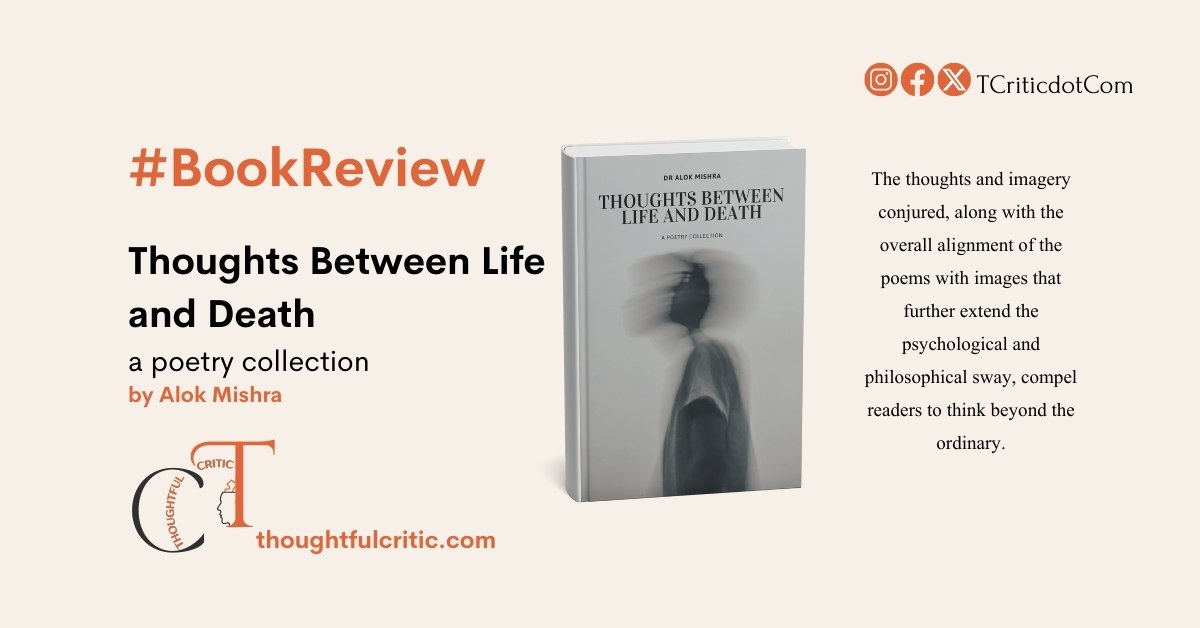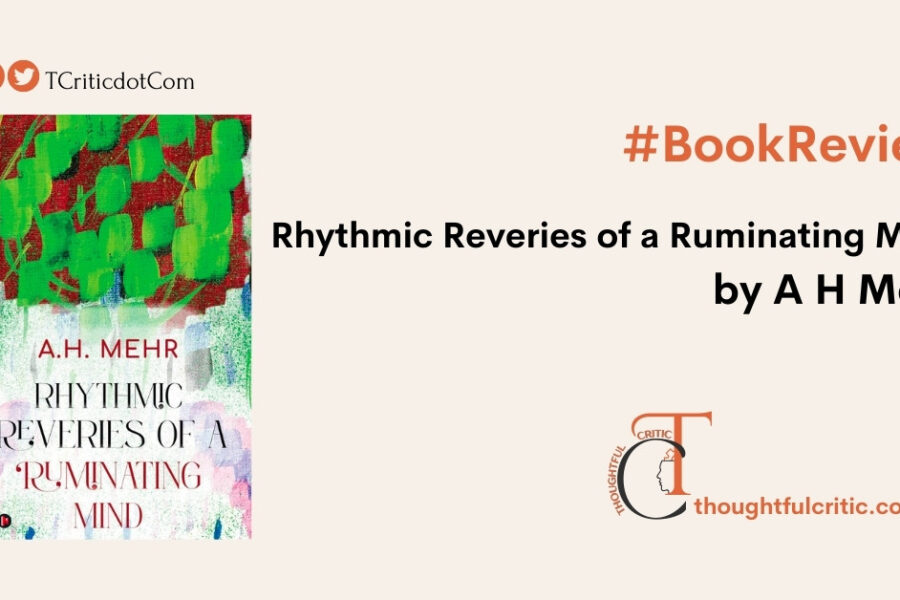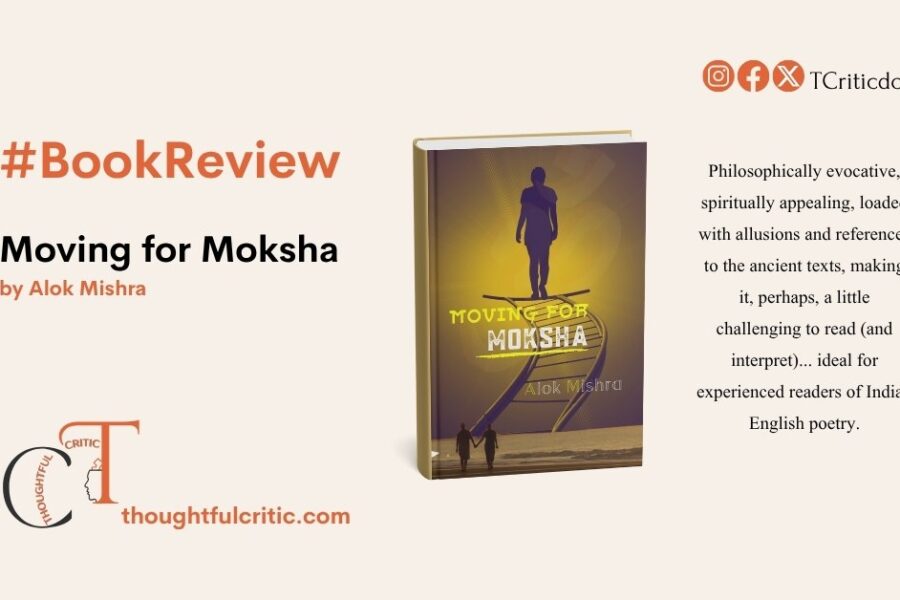Dr Alok Mishra’s Thoughts Between Life and Death is a poetry collection that balances itself on the thresholds of existence, mortality, memory, and transcendence. The very title sets the tone for what unfolds in the subsequent poems: a meditative and reflective exploration of the fragile yet profound space between birth and death, between the material and the metaphysical, between silence and expression. Accompanied by carefully chosen images that visually mirror the emotional and intellectual contours of the poems, the collection is as much a philosophical inquiry as it is a lyrical offering.
The images, ranging from cosmic hands playing with stars and planets to the solitary figure on a swing under a barren tree to the divine presence of Lord Shiva, expand the scope of the verses. They suggest that Mishra does not merely write from within the temporal world of human experiences but continually opens his poetry to the metaphysical and cosmic registers. In this sense, the visual-textual interplay creates a collection that is both intimate and universal, multidimensional.
Poetic Engagement with Loss and Memory
The opening poem We Two Parted? sets a paradoxical tone. While one expects a sense of anguish at separation, the poet describes the absence of agony. The detachment depicted here gestures towards a higher form of acceptance, one that resists the sentimental excess often associated with parting. This approach is not coldness but a reorientation of perspective. The accompanying image of two intertwined hands surrounded by cosmic motifs resonates deeply with the poem: even in parting, there is a cosmic connection that transcends the immediate pain of separation. Mishra thus situates personal relationships against a cosmic backdrop, implying that loss itself may not be absolute but part of a greater continuum.
Similarly, The Lost Battle meditates on time wasted and the irretrievability of past opportunities. Yet, instead of despairing, the poem transforms longing into a recognition of the “night of passionate solitude.” Here again, solitude is not emptiness but an experience of fullness, an occasion to embrace the metaphysical solitude that aligns with creative yearning.
The Garden, the Maze, and the Swing
Several poems employ natural and spatial metaphors to reflect human predicaments. The Garden and Its Shadow personifies grandeur as a shadow that simultaneously enchants and imprisons. This poem resonates with the third image of the swing under the tree, where a solitary figure sits in melancholic silence. Both the image and the poem highlight the tension between abundance and decay, between the beauty of life and the inevitability of decline.
In The Chase, the maze becomes a metaphor for human relationships and communication breakdown. The insistence on walking, the silence that dominates, and the exhausting terrain mirror the struggles of navigating human emotions. The absence of dialogue is not only a personal predicament but a symbolic representation of how individuals remain locked within existential mazes. The imagery of the solitary figure on the swing strengthens this reading, as it visualises the loneliness and silence that often accompany emotional entanglements.
Justice Beyond Sentiments
In Justice, Mishra strips human emotions of their dominance over notions of what is fair. “A mother will die. A child will be saved. A serpent will always bite.” These stark lines present justice as an objective, almost cosmic principle, untainted by human melodrama. The imagery of hands manipulating stars and planets complements this idea, suggesting that the cosmos follows its own laws that remain indifferent to human suffering or expectation. This aligns with Mishra’s recurrent philosophical inclination: human life is not governed by sentimental justice but by a larger, inscrutable order.
The Interplay of Darkness and Light
Several poems in the collection grapple with the interplay between darkness and illumination, both literal and metaphorical. Unexpected describes darkness as a catalyst that reveals an inner light, a discovery of self-sourced freedom. The juxtaposition of outer gloom and inner brightness resonates with the cosmic imagery in the collection—hands filled with stars, an eye in a palm, and the recurring motif of celestial bodies. These images suggest that the universe is not external but internalised; the cosmos resides within human consciousness.
It May Rain and Fragile return to human vulnerability. Rain becomes a metaphor for the inevitability of sorrow, while fragility manifests in the shattering of wisdom, knowledge, and detachment before a single tear. The image of the swing amplifies this fragility: the broken seat, the solitary childlike figure, and the barren tree together embody the precariousness of existence.
Philosophical Inquiries into Art, Poetry, and Wisdom
One of the strengths of Mishra’s collection lies in its meta-poetic reflections. The Art and the Artist interrogates the human longing for poetic justice and the flawed assumption that art can mirror divine order. Mishra sharply contrasts human attempts to lure the “architect” with the universe’s perfect mathematics. Similarly, Heartbreak critiques the romanticised association of poetry with personal pain. For Mishra, poetry is not a product of broken hearts but of imaginative creation—making “flowers in the desert” or “oceans on Neptune.” This insistence on imagination over sentiment positions Mishra’s poetry within a tradition that values creativity as a form of transcendence rather than mere reflection of suffering.
The final poem in the collection, Mind and Heart, serves as a philosophical culmination. It portrays wisdom as deceptive, often masking innocent truth beneath a veneer of artifice. The poem condemns wisdom as the “ringleader of thugs” that distorts spontaneous truth into manipulated narratives. Here, the imagery of the cosmic hand holding an eye encapsulates this idea: the eye represents truth and perception, while the hand signifies manipulation, power, and craft. Mishra’s scepticism towards contrived wisdom reinforces his call for authenticity in art and life.
The Role of Regret, Loneliness, and Transcendence
Mishra’s treatment of regret in And Regret is both playful and profound. By repeating “who knows what I know?” he exposes the futility of human obsession with knowledge. Knowledge itself becomes a burden, a paradox that isolates rather than liberates. This resonates with Upgrade, where loneliness becomes a path to wisdom. The transformation of loneliness into a recluse and eventually into self-realisation reflects Mishra’s spiritual leanings, a movement towards dissolving the ego.
The presence of Lord Shiva in the included artwork further reinforces this theme. Shiva, the ascetic god of destruction and renewal, becomes a fitting symbol for Mishra’s preoccupation with life’s cyclical nature, the burden of knowledge, and the transcendence of ego. By including this image, the collection links personal meditations to a broader Indic philosophical framework. The cosmic hand, the swing, the fish near a hook—all carry layered symbolic resonances, suggesting karma, fragility, and the eternal dance of creation and dissolution.
Between Life and Death: A Cosmic Dialogue
The collection’s title comes alive most vividly in poems like Wide Blue Horizon and Watching Sunset, Under the Tree. In the former, Mishra toys with the liminal space between dream and reality, death and waking life. The speaker sees himself dead yet alive, only to be jolted awake by thirst. This playful yet serious exploration of mortality underscores the inseparability of life and death. In the latter poem, the tree becomes a witness to life’s journey, from childhood play to adult contemplation. The imagery of supporting the tree as it ages mirrors the inevitable cycle of decay and renewal. The final acceptance that “we neither come nor go, we are one with the eternal flow” encapsulates the philosophical spirit of the collection.
Conclusion: A Fusion of Word and Image
Thoughts Between Life and Death is more than a collection of poems; it is a philosophical and visual tapestry. The poems oscillate between intimacy and universality, despair and hope, loss and transcendence. The accompanying images intensify this oscillation, offering symbolic anchors to the reader’s interpretation. Hands filled with stars, the solitary swing, Lord Shiva’s calm face, and the cosmic eye—all these visuals extend the poetry into new realms, inviting readers to experience the liminality of existence both emotionally and intellectually.
Alok Mishra’s collection demands slow reading. It resists easy sentimentality, instead compelling readers to question their assumptions about art, justice, wisdom, and mortality. By intertwining poems with symbolic images, Mishra creates a layered work that embodies the space between life and death, urging us to see beyond binaries and to embrace the continuum of existence.
Get a copy from Amazon India – click here.
Review by Ashish for Thoughtful Critic
..
houghts Between Life and Death by Dr Alok Mishra, a review of the poetry collection
-
Thoughtful Critic's Rating
Summary
Poems in the collection are introspective. The thoughts and imagery conjured, along with the overall alignment of the poems with images that further extend the psychological and philosophical sway, compel readers to think beyond the ordinary.




